[TrainingTalk] Periodized Nutrition and Metabolic Flexibility for Endurance Performance: Data and Insights from a Case Study
Fueling for the work required and its implications for fat oxidation, running economy, performance and more.
There’s a lot to say about these past few months, during which I shifted from a predominantly high-carb (and sometimes low-quality) diet to a heavily periodized diet and a “fueling for the work required” approach (please keep reading for details and explanations of these terms).
But let’s start with some highlights from this experiment:
Large improvements in fat oxidation:
Before: 0.30 grams/minute at 5’43”/km, 0.15 grams/minute at 4’25”/km.
After: 0.85 grams/minute at 5’43”/km, 0.85 grams/minute at 4’25”/km.
Improved body composition*:
Body fat from 16-18% to 10-12%.
Improved running economy**:
Lower cost of running at most speeds.
Improved health***:
Subjective well-being, gastrointestinal health, and blood biomarkers.
Improved performance:
As tracked in hard interval sessions, long race simulations, aerobic efficiency, and of course, actual race performance.

All the details are below, but first, a few important caveats:
The main goal of this project was to improve my fat oxidation and gastrointestinal health for ultrarunning events. In the process, I went through many changes that I think can be useful to document, e.g., in running economy, body composition, and performance, even though these are less straightforward to interpret than the change in fat oxidation. Hence, keep in mind that:
Improved body composition* is largely due to an initial phase of caloric deficit, regardless of macronutrient distribution.
Improved running economy** is a combination of dietary and training choices that cannot be separated in my data. Regardless, given that often a concern with lower carbohydrate intake is reduced running economy, I thought it was important to analyze and report (and was glad to have not experienced any decrement, but the contrary).
Improved health***: apart from feeling better and getting rid of gastrointestinal issues, I also reached a better cardiovascular profile in terms of blood biomarkers, but this wasn’t without some trial and error, which I will detail below.
Alright, let’s dive into the details now.
What’s Periodized Nutrition?
In the words of Asker Jeukendrup: “Periodized nutrition refers to the planned, purposeful, and strategic use of specific nutritional interventions to enhance the adaptations targeted by individual exercise sessions or periodic training plans, or to obtain other effects that will enhance performance longer-term”.
In simple terms, periodized nutrition typically involves modulating carbohydrate intake based on training phases and workout intensity. It seems obvious that the fuel we use should change depending on the demands of our training, but this is an often overlooked aspect.
Done well, this approach can improve both fat oxidation and endurance performance, as what we want is not to focus only on the low-carb side of things but to improve metabolic flexibility, i.e., our ability to oxidize fat up to certain (potentially very high) intensities, while maintaining or further improving our ability to oxidize carbohydrates too. That’s what we can obtain when using a nuanced, periodized approach instead of joining cults or following high or low-carb fads.
If you are interested in learning more about periodized nutrition and metabolic flexibility, apart from the scientific literature cited below and podcasts with experts such as Dan Plews, I can also recommend Bob Seebohar’s nutrition course, or simply his books, which cover these topics very well (no affiliation, I took is course later on - weeks after my own tests and experiments - and thought it is some of the best educational material out there on the topic).
Motivation
On my end, I had various reasons to finally start paying more attention to nutrition. Some of these reasons are endurance performance-related. Despite training for many years at high volumes and low intensities, my fat oxidation rates were near zero, even at the lowest intensities. Hence, my poor fat oxidation was an important limiter during ultramarathons and could benefit from a boost. This can also explain part of my large(er than expected) performance decrement between e.g. a 10 km or half marathon race and a 50 km race, which I had so far associated with a poor running economy. On top of this, in my previous 100 km races, I always had gastrointestinal issues - despite plenty of gut training. Gastrointestinal issues might be prevented or limited by needing less fuel, a likely outcome of improved fat oxidation.

Additionally, I was recently coming from a period of suboptimal performance and I was aware I had slipped a bit with my diet (oh, Italy), putting on weight and experiencing gastrointestinal problems outside of training for several weeks at the time - something quite debilitating, even if I could not link it to any food in particular (maybe because that type of food was so predominant in my diet!).
Hence, I figured I could try to address all of the above with a periodized nutrition approach that also involved a fair amount of caloric deficit to start with (the deficit is something I had done before, with the goal of improving body composition for running performance, but the periodized nutrition approach was a first for me).
Goals recap:
Improve performance: if I improve my body composition and become less dependent on carbs, I can probably run better at Passatore.
Improve fat oxidation and metabolic flexibility so that I can rely less on carbohydrates during a long race but still run hard for shorter sessions and races. This is all about periodization, not going low-carb only.
Reduce gastrointestinal issues during long races (added benefits in the heat where blood flow is redirected to the periphery for cooling rather than digestion).
Improve body composition, which might help with running economy and performance in the heat/cooling.
Improve health:
Reduce gastrointestinal issues outside of training.
Context
Below, I document the first months of my experiment. In the first 7 weeks, I was mostly concerned with caloric deficit, then for the following 3 months, I was stable in body composition and focused only on periodizing macronutrients (i.e., eating fewer or more carbohydrates depending on the demands of training) - which is what I consider the interesting part of this experiment:

My dietary habits over the past 40+ years have been largely shaped by cultural norms based on where I was born, and not performance goals. This means that when I say low-carb, I actually mean “lower carb for me, with respect to my history”, and not even close to a keto diet (on average, I hit ~50g of carbs only once or twice per week, all other days higher than that, as we will see later). Hence, let me say this again: this experiment is about periodizing nutrition and metabolic flexibility, not about eating low-carb all the time. Once more: periodizing nutrition involves eating carbs!
As my friend Dan Plews would say, context before content. In other words, we need to consider the bigger picture - context - before diving into specific actions or protocols.
Training Context
While my approach to periodized nutrition and dieting was quite aggressive, the current training context allowed for it. What I mean is that my main race of the year is at the end of May (100 km del Passatore), and between December and February, I was in Base training, doing mostly easy training and short workouts or long trail runs/hikes that are not demanding. The total workload was about 110 km/week, or 10-12 hours per week, hence quite a bit lower than my peak training the month before Passatore (180-200 km/week, 20+ hours), when I will certainly eat more carbohydrates.
Another important aspect here is that I have not only changed my nutrition but also made some adjustments to my training to compensate for possible negative outcomes. For example, given my poor running economy and some conflicting results about low-carb diets and running economy, I have tried to counterbalance this potential drawback with an extra dose of short, fast work (weekly sets of both strides and hill sprints).
Additionally, I have also reduced the frequency of hard workouts. In particular, I have shifted to fewer big, hard sessions (at this point, just 1 per week), but with plenty of “extra work that is not too demanding” each week (for example, strides and hill sprints done well, 90’ high-end z2 with a hard finish, etc.).
Principles and Approach
Given all of the above, here are the basic principles and approach I have used, which is a combination of 1) my previous experience, history, and context 2) scientific literature on the topic of periodized nutrition for endurance performance (Burke, Morton, Impey, etc.) together with reports from coaches that have been doing this for a long time (e.g. Couzens, Plews), and of course, 3) some good old common sense.
Fuel For the Work Required
Overall, I have used various "train-low (carb)" strategies but made sure I would fuel properly my key workouts. I am not doing any long-term macro (carbohydrate) restriction, but I am adjusting day-by-day and meal-by-meal, depending on what is needed for a specific training session (Impey et al.) - even though the overall amount of carbohydrates was certainly much lower than in my previous regular diet, even on loading days. This is a Right Fuel, Right Time approach, as Dan would say.
The day-by-day and meal-by-meal adjustments are quite obvious when we look at the plot below, in which energy intake and expenditure follow each other, and carbohydrate intake is higher when needed.

This approach allowed me to train quite frequently in a low-carb state (e.g., after a low-carb breakfast), working proactively on my metabolic flexibility and fat oxidation while still performing well for high-intensity sessions.

Next, we look at the specific strategies I have used.
Key “Training Low” Strategies
Training adaptations can be amplified or dampened by nutrition (Jeukendrup, Burke, et al.). In this context, we can use “training low” strategies, i.e., we can train with low carbohydrate availability, to enhance fat oxidation. Common approaches are fasted training (Rothschild et al.), sleep-low (Marquet et al.), and twice-per-day training (Hansen et al., Kian Yeo et al., Soegaard et al.), which can all stimulate fat metabolism, improve glycogen storage, and support long-term endurance adaptations. Ultimately, finding the right balance requires experimenting with these methods to align with individual goals and training phases, as well as with everything else going on in our lives. For me, training low means having a low-carb breakfast but still eating plenty of calories. This approach is backed by research showing that a breakfast made of, e.g., 67% protein and 32% fats leads to very similar results to training fasted, while it differs greatly from the fat oxidation response you’d get when training with high carbohydrate availability (Rothschild et al.).
Here is how I structured my periodized nutrition approach:
Training Low (often called “fasted” training, but for me, this was a breakfast of protein and fat):
Non-workouts (i.e., low-intensity training, strides, hill sprints, z2, etc.): I have trained after a low-carb breakfast on most days (4-5 times per week), excluding days in which I had a hard workout (see also the diagram below). In particular, for all runs that were not hard workouts or long runs with intensity, including high-end zone2 runs, fast finish runs, strides, and hill sprints, i.e. runs that include some work but are not proper, demanding, high-intensity sessions, I had a low-carb breakfast, typically with fewer than 10g of carbs. As mentioned earlier, I do maintain adequate overall caloric intake (e.g., I could have 10g of carbohydrates but still eat 600 kcals for breakfast before a 90’ z2 run).
Long runs: for long easy runs (i.e., long runs that do not include tempo or threshold segments, which is the case for me during Base training), I had the same low-carb breakfast. Here, however, I also had some food during the session, but I would still have fewer carbohydrates than in the past, e.g., a few dried apricots every 90 minutes or so, if staying out for 4-5 hours (maybe 20-30g of carbohydrates for the entire 4-5 hours, mostly going by “feel of hunger”).
Twice-per-day training and sleep low, train low:
Another strategy to improve metabolic flexibility is to train twice per day and stay low on carb intake between sessions, or after the second session, then train again in the morning after a low-carb breakfast (sleep low, train low). I’ve done twice-per-day training once per week, typically. The way that works best for me is to double after a hard morning workout, hence making it also a post-exercise carb-restriction strategy despite emphasizing pre-workout carbohydrate intake for optimal performance during the workout. To recap: high-carb breakfast, hard workout, low-carb lunch, evening easy run (60-120 minutes), and low or moderate carbohydrate intake for dinner.
For hard sessions, there are normally two ways you can have more carbs: you could load in the evening before, or you could do it in the morning before training (or both). I’ve tried various combinations of these options, and personally I execute the workout much better when I load in the morning, regardless of what I had for dinner (again, this might be due to not doing workouts that are too long in this training phase; see next point). This is also consistent with the scientific literature, as morning fueling can also replenish glycogen stores that get depleted during the night (Jeukendrup). This might be different for you if you prefer to train fasted or if you have other constraints, but currently, I tend not to worry too much about eating more carbohydrates in the evening.
Practically speaking, here is what I have put together:
Measurements and Results
So, how did it go?
In this section, we look at both laboratory data on metabolism and training data that acts as a proxy for performance, given that I am not racing yet.
Laboratory Tests
One of the challenges of these experiments is that it’s difficult to capture how things are progressing unless we have access to a lab with indirect calorimetry. At the moment, I do not have access to a device for frequent testing, and therefore, I could only test once after 8 weeks of periodized nutrition. In this context, we need to keep in mind that the body will use whatever is available as fuel, and as such, the numbers we get from testing can be impacted by our recent diet, up to the breakfast we had (or didn’t have) before testing.
Hence, I gave a lot of thought to the protocol to test fat oxidation, and eventually, also thanks to a few good practical studies that Dan Plews and co-authors have done, I have narrowed down the range of options, e.g. no need to test fasted, which would be unrealistic for me (I had about 5-600 kcals of protein and fats before the test).
The protocol I designed included a double sub-maximal ramp test with carb intake (40g) between stages:
This way, I could get a "best-case scenario" in terms of potential improvements in fat oxidation during the first stage, which I think is important because I wanted to see if the dietary changes were all for nothing or not.
The idea behind having 40g of carbs between stages and then testing again after 20 minutes was to get some insights on how quickly these things change (even just answering these questions: what’s the impact of a gel before training? What would be the difference in a race after having a higher-carb breakfast? Is baseline metabolism the most important thing, or does it get acutely “impaired” by recent carb intake?).
Finally, I did not test above 50 km race-pace (or “between thresholds” territory), as I did not expect that my fat oxidation would be any good at that point. We’ll see that I was wrong.
Fat Oxidation
Fat oxidation was well beyond my expectations. In particular, I was expecting (hoping?) that around fat max (the lowest speeds tested here), I would see meaningful progress. I was, however, expecting to see changes fading quickly, especially as we approach the first lactate threshold (LT1) and quicker speeds. At that point, I thought I’d be back to the usual rates of almost entirely burning carbohydrates.
It was a big surprise for me to see that at 13.5 km/h or 4:25 min/km, I was still predominantly burning fat. Lactate is not shown here, but I passed my first threshold somewhere between 12.5 and 13.5 km/h, hence, the last bar is already tempo territory for me (which matches my expectations based on training; that’s a pace I could race for a 50 km race at best). This means that I had the same fat oxidation rates at 60-65% of my maximal heart rate and at 80-85% of my maximal heart rate. Not so bad.
Below is the same data but looking at overall oxidation rates, which remain at 0.8 g/min across all intensities, for fat:
As reported at the beginning of this blog, here are the rates in grams per minute:
Before: 0.35 grams/minute at 5’43”/km, 0.15 grams/minute at 4’25”/km.
After: 0.85 grams/minute at 5’43”/km, 0.85 grams/minute at 4’25”/km.
Note that for this metabolic data, I am comparing against my best self: the data on the left side of the figure above is my data in the best shape of my life (36’40” for a 10 km, see here), when I was the same weight and body fat as now and training with similarly high volume, but still eating a very high-carb diet all the time. The big difference in this case is the introduction of a periodized nutrition approach. Hence, when it comes to fat oxidation, we can say the experiment worked really well.
Endurance athletes and fat oxidation myths
I wrote earlier that I did the same protocol two times, and I had 40 grams of carbs in between. The main goal was to answer this question: Is baseline metabolism the most important thing, or does it get acutely “impaired” by recent carb intake? Obviously, the hope is that the chronic dietary change has a larger effect than the acute impact of carbohydrate intake (especially in the context of a race, when I do plan to have more carbohydrates the day before and the morning of the race, as well as during the race). However, the research shows changes up to 30% just based on carbohydrate intake pre-testing. In my case, there was only a minimal change in the data: I had pretty much the same fat oxidation rates after carbohydrate ingestion. The chronic change in diet, impacting metabolism, was robust.
I have to say, at this point, it started to bother me a little when I hear nutritionists or coaches saying that endurance athletes shouldn’t worry about periodizing nutrition and should just eat lots of carbohydrates because fat oxidation takes care of itself. This is a lazy way of thinking, very well aligned with the typical “I can eat whatever I want because I’m a runner”. As endurance athletes, it speaks to our bias. We love to exercise, and we might not love as much to pay attention to what we eat. Hence, that message is all we want to hear, and we are quick to believe it, without any proof or testing of our own metabolism.
Unfortunately, that’s not how it works (in terms of both health and performance). My data below shows it very clearly, as only changing nutrition could move up fat oxidation. In Bob Seebohar’s words, 25% of metabolic efficiency is training (volume and intensity distribution), while the remaining 75% is nutrition. In an image:

Fat Oxidation: Making it Practical
Looking at the data above, we might still wonder: how does that change in fat oxidation impact fueling requirements in a race? Does it really matter?
If we do the math, we can see it makes an enormous difference.
Say, for example, that I eat a high-carb diet and I want to run Passatore in less than 9 hours. My fat oxidation rate with this diet is 10%. At a sub-9 pace of 5’25-30”/km, where I burn ~723 kcal/hour, 90% of this energy comes from carbohydrates, which amounts to approximately 650 kcal/hour from carbs. For a 9-hour race, this equates to 5856 kcal needed from carbs. Since I start with full glycogen stores of approximately 2000 kcal, the remaining 3856 kcal must come from external carbohydrate sources, which equals around 964 grams of carbs in total. Dividing this by the 9 hours of the race, I would need to consume around 107 grams of carbs per hour. For someone with a mild intolerance to wheat, frequent nausea and gastrointestinal problems in very long races ran at a decent intensity, and preparing a race that starts in the heat (i.e., exacerbating gastrointestinal problems, as blood flow is diverted to the skin for cooling, and cannot assist as much in digestion), this is very unlikely to work (and indeed, it didn’t work in my past experiences, despite not even trying to ingest that much food, but approximately half of that, and despite “training the gut” - i.e. always eating high amounts of carbs in training and outside of training for years).
Say, instead, I keep going with periodizing my diet and a right fuel, right time approach. With a fat oxidation rate of 60% at LT1 and beyond, I’m able to conserve more glycogen. At a sub-9 pace of 5’25-30”/km, where I burn ~723 kcal/hour, now only 40% of this energy comes from carbohydrates, which amounts to 290 kcal/hour. For a 9-hour race, I would need 2610 kcal from carbohydrates. As in the previous example, we can assume I’m starting with full glycogen stores of approximately 2000 kcal, then the remaining 610 kcal would need to come from external carbohydrates, equaling approximately 152 grams of carbs in total (!). Dividing this by the 9 hours of the race, I would need to consume only about 17 grams of carbs per hour (15% of the previous requirements when I was on a chronic high-carb diet).
The optimal rate or what I decide to use on race day might be higher than these 17 grams, but that's what my body is now able to do, only because of using a more periodized approach. This is a huge gain for someone with my context, limiters, and goals. No doubts here.
Running Economy
Running economy is often mentioned as the one aspect that you will compromise with a low-carb diet. Again, here I am just heavily periodizing diet. I am not eating low-carb daily, and as such, this might not be the case.
Still, it was worth checking. Given that I have been rather obsessed with my poor running economy for over a decade, and I had finally turned it into something acceptable, it would have been a bit depressing to take a step back. Fortunately, we see the opposite, with improved running economy when running quicker than 10.5 km/h:
Happy with that too. As mentioned at the beginning of the blog, here we look at combined changes in diet and training, and I would not claim that my diet has improved my running economy. Most likely, my diet has not compromised negatively my running economy.
I would also keep in mind that even if the data looked a bit different, it would not necessarily mean that the reduction in economy as defined by oxygen cost should lead to a decrease in performance. The oxygen cost of running is different from the energy cost of running. While burning fat costs more oxygen, we are sparing glycogen, and our energy cost might be the same or even better than when relying less on fat. What does this mean for performance? When energy cost is the limiter, and not oxygen cost (e.g. a long event), maybe we should be looking at that (i.e. kcals/min), as opposed to changes in VO2, to assess our economy. More food for thought.
Stress Response
Lots of changes going on in my body and physiology over these months, hence a look at my stress response via HRV measurement using the HRV4Training app, might shed some light on how I’m coping.
In terms of protocol, I measure HRV in the morning, shortly after sitting up, as this procedure allows to capture training-related stressors not visible in night HRV data (as I discuss in depth here).
Both in the scientific literature and in my own previous experience, HRV increases, and resting heart rate is highly suppressed with reduced caloric intake. The same happened this time as during a caloric deficit, the body may reduce its metabolism as an energy conservation mechanism, which can also lower heart rate.
Based on this data, I made some changes to HRV4Training Pro, which now displays also Normalized HRV, which I currently consider a more useful parameter to track our stress response since it accounts for changes in resting heart rate (for example, if our HRV is within normal range but resting heart rate is highly suppressed, our HRV is in fact lower than our normal).
Something different happened when I switched to periodized nutrition and lower carbohydrate intake. The response to this dietary change was a marked drop in HRV, with no change at all in resting heart rate, which remained suppressed below my normal range. I find the decoupling between resting heart rate and HRV particularly interesting as it shows that there is information in HRV that is clearly not present in resting heart rate alone.
The change in HRV is consistent with what was reported in a study by Dostal et al. Consistently with published research, my HRV data has also re-normalized quickly after an initial phase in which there was a large suppression, possibly due to a combination of a reduction in blood volume (another physiological artifact that should not be overinterpreted as “positive or negative”, regardless of HRV), and an actual stress response.

In terms of resting heart rate, it seems to be a good meter for caloric deficit and not much else. We can see in the data above how the shift to a different macronutrient distribution does not impact resting heart rate data and how resting heart rate re-normalizes as soon as the caloric deficit stops.
The block between the beginning and middle of January, when HRV is highly suppressed, was my worst block in terms of running performance. I’ve done what I had planned but overall underperformed most of the time.
It was clearly an adjustment phase, well reflected in the morning HRV data collected with HRV4Training. From this moment on, my data has always been stable.
Behavior and subjective data
When it comes to tracking how we are doing, not many things are as useful as a well-done questionnaire filled in consistently (yes, I just said that).
This is one of the most appreciated features by coaches using HRV4Training, and you can easily see why when looking at the data in the longer term (in HRV4Training Pro, you can also see your normal range and baseline for subjective data, which helps in contextualizing changes).
Below, we can see the following:
My motivation remains high throughout the experiment. This is important as a reduction would be an important warning sign, often a precursor of overtraining or burnout.
During the initial caloric deficit, I struggle with energy levels and perform poorly in training, then start doing a lot better when reaching a state closer to energy balance at the beginning of February.
In the app, I also annotate my sleep time (just the bedtime, as wake-up time is when I take the measurement). Surprisingly enough (or not?) this method works a lot better than "wearables pretending to capture when you fall asleep”). Switching diet has impacted my sleep, meaning that I feel good and rested while sleeping less, and I have also started napping less frequently, something I was doing daily. I did not see this coming at all.
Performance Metrics
I’ve discussed here how I normally track performance in endurance training, without specific tests or races. In short, these are the main aspects:
Interval analysis: I use this tool to compare different sessions, especially when doing VO2max or threshold blocks, as I often do similar or the same sessions. While we don’t expect progress each session, in this phase, I expected to progress, something we can see quite clearly in the data below, with my typical 2-4 x 2000m session getting to peak performance levels (for my standards, of course). I took the opportunity to add a feature to HRV4Training Pro, which now shows a graph of pace and heart rate for selected intervals sessions.

Lactate threshold estimation (LT2, or critical pace/speed): I keep track of this estimate throughout my training, as it is also indicative of what I can race in shorter distances, or what I should aim at in terms of interval speed. This is a prediction model I built to estimate running performance based on workout data collected during the previous 4–6 weeks. You can find the paper here. During this block, in line with the changes shown in the interval sessions above, the critical pace estimate also gradually improved, eventually settling at 3’50”/km.
Aerobic efficiency: I use this in the medium or long term to see if there are any meaningful changes in internal load with respect to external load, removing confounders (i.e. answering the question: is it getting easier to run faster?). I also use it in the short term to see the effect of e.g. environmental stressors, fatigue, etc. - it’s one of the most useful tools, I believe. Below, we can see my progress for the same run, showing how it was indeed getting easier to run faster.

For these analytics, I used HRV4Training Pro and Strava.
Additionally, for rare but key long sessions (e.g. things like long runs at marathon pace, race simulations for ultras with a focus on trying out race-specific things like elevation changes, nutrition, clothing, etc.), I analyze the workout in relation to my training, expectations, and history.
While the analytics above all showed large progress over the first 2 months of the experiment, it is obvious that many of these changes in the short term have a link to body composition changes, more than anything else. This short period cannot really give me the performance data required to understand how things change when a possible shift in fat oxidation can play a more important role (long steady efforts, for example).
However, between March and May, I could finally put my improved fat oxidation to the test.
I went out for long race simulations, which outperformed my best past performances (as in the one shown below, details here).
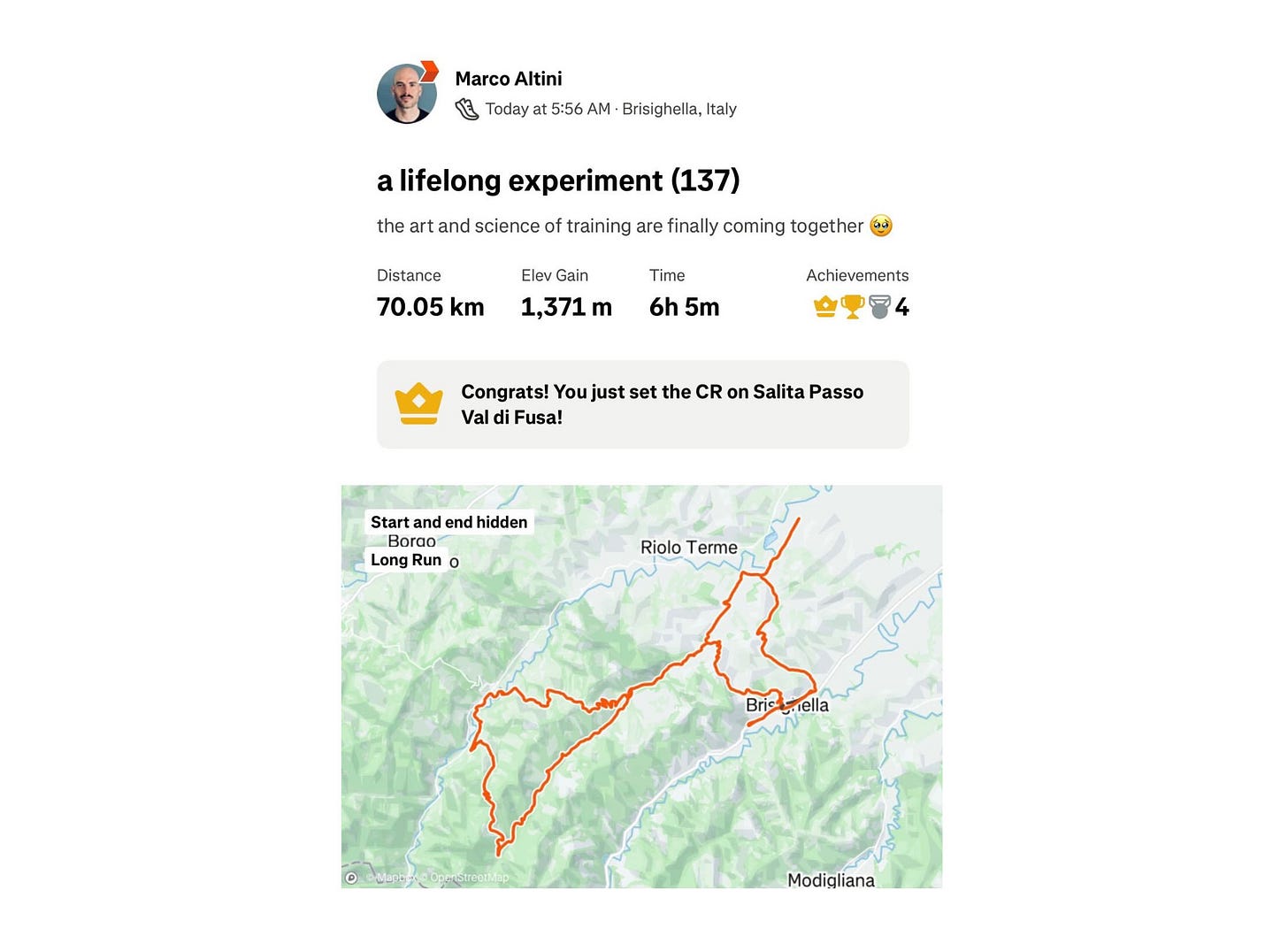
As well as for races, e.g., improving my time at the 50 km di Romagna by 10 minutes, while intaking 110 grams of carbohydrates overall, or about 28-30 grams per hour (and no cramps, no nausea, no fatigue, no walls, no fading..):
Top-end and carbohydrate oxidation
Here, I want to address yet another common comment or concern. It seems that some people are quite worried that if you do not eat hundreds of grams of carbs per minute day and night, you will lose your top-end and ability to oxidize carbohydrates.
Once again: we are periodizing nutrition, we are not on a keto diet (and even then, it’s all arguable, as recent data shows). My point here is that a little stimulus goes a long way. In fact, not only my performance in shorter intervals is as good as it has ever been, but my lactate at the end of a hard session is higher than it was on a high-carb diet during a VO2max test or similarly hard session. This would not be the case if a periodized diet would impair carbohydrate oxidation and metabolism. Instead of speculating, and “worrying about losing abilities and adaptations” that you are not testing or measuring, test, and you will see that proper periodization can be the best of both worlds.
When periodizing nutrition, we do eat carbohydrates. We eat carbohydrates before workouts and before long steady efforts as well as during these sessions, which keeps our enzymes happy.
Nutrition periodization is all about metabolic flexibility, using much more fat as fuel in an ultramarathon or at low intensity in general, and then oxidizing more carbohydrates for short, high-intensity efforts. Adjusting nutrition based on the demands of training is how we can improve flexibility without compromising in any way our ability to perform at high intensity.

To me, periodizing diet is akin to periodizing training. Do you always run all out? Is that how you get better? Or do you alternate hard sessions and easy sessions, and that’s how the body adapts and improves? Consistency in a stimulus leads to improvements even when in small doses. We tend to overestimate the amount of stimulus required because we live in a society of “more is better”, without much critical thinking. I have done 1 single hard workout per week in the past 20 weeks and made large progress (in performance). Similarly, I had 1-2 high-carb days per week in the past 20 weeks and also made large progress (in both fat and carbohydrate oxidation, i.e. metabolic flexibility). It’s the same with most things, otherwise, all we might be getting is overtraining, burnout, or chronic disease. More food for thought there.
Body Composition Changes
Similarly to other times in the past, I’ve lost about 9-10 kg in 7-8 weeks, then remained stable for the following months. When I started with the experiment at the end of December, I struggled with energy levels for about two weeks, as expected. After that initial phase, I started feeling much better, and on most days I wasn’t making much of an effort in terms of the caloric deficit but I was mostly focused on the macros and periodized nutrition approach, which was the novel aspect for me (in previous years, even when dieting, I'd still eat predominantly high carb, just lower kcals/day).
My running performance started improving again at the beginning of February. No surprise there, it’s unlikely we’d make progress in a highly catabolic state. Since then, my weight and body composition have been stable as I maintained my periodized nutrition approach, but always in a state of energy balance, i.e., without any caloric deficit. To improve performance, we need to eat enough.

Getting Practical
In this section, I provide some additional practical details on my sample diet and macronutrient distribution to make the whole process a bit easier to understand. If you have questions, please use the comments below, and I’ll get back to you.
Sample Diet
Normally, I do not track my diet, but in mid-January, I started to think about this blog and figured I could provide more useful practical insights by logging my food intake, hence I started doing so. That’s also how I put together the plots you saw above, with food intake vs energy expenditure, or macronutrients per day or by meal type. I hope those are useful to give you a good idea of the process and some additional context.
Below, I’ve added two examples for different days. First, a low-carb day:
and then a high-carb day in which I ran twice. In this case, I had more carbs at lunch. Later on, when I got used to the diet and to training twice per day, I started staying low between training sessions, as described above in the training-low strategies section:
All of these are, of course, approximations, but the goal is not to get an exact amount of kcals or macros but to get an idea of how things are trending and of large differences between days based on training requirements. This approach is really meal by meal and day by day, not a strict change in macros for a prolonged period of time.
The logging is a bit of manual work (I wrote everything in a Google Excel sheet so I could then process the data in Python with Colab), but automation is highly overrated if you ask me. Doing the work, just like measuring our physiology intentionally in the morning (as opposed to using a device for passive tracking at night), makes it so that we become more self-aware, which is the whole point of tracking.
Below is again the distribution of macronutrients across meal types. It’s the same info I showed earlier, but this time in percentages instead of in terms of totals:

Blood Biomarkers
As we’ve seen in this blog, over the past few months I’ve made significant dietary changes. To recap, back in December, I had not yet adopted a periodized nutrition strategy. I was heavier, and my diet included more processed carbs and saturated fats. In mid-December, I started with a large daily caloric deficit to get back where I was 2 years before in terms of body composition. Starting in January, I also shifted to a periodized approach, which included more low-carb days aimed at improving fat oxidation. These changes led to a ~10 kg weight loss by February.
When I went into this experiment, I also had a goal of lowering my (LDL) cholesterol level, as my family has a history of high cholesterol (and associated issues), and mine was elevated. Thus, during this initial lower-carb phase, being aware of my higher-than-ideal LDL, I limited certain foods (cured meats, hard/aged cheese, etc. - plus, due to the overall shift towards lower carb days, I’ve almost completely removed sweets and ultra processed foods), but my lab data still came back with a large increase in both LDL and HDL, which I have to say, was a surprise to me (see data in the table below).
Talking to nutritionists about this, they brought up how maybe the large and quick weight loss might have impacted the data. Since then, I learned this is a whole topic, i.e. lean and active individuals on low-carb diets having extremely high cholesterol levels (here is an interesting podcast discussing some of the latest research). Basically, there’s some debate around high cholesterol in active and lean individuals, with some arguing that being fit and lean might offset cardiovascular risk. Personally, I remain cautious. To me it sounds like the “I run a lot so I can eat what I want” mentality that I have moved away from in the context of improving metabolic flexibility. Maybe being lean and active is protective in some forms, but I still wanted to see what I could do to turn the situation around, while maintaining my newly found fat oxidation rates.
What to do then? Since those tests in March, I’ve refined my strategy further — not just to support ultra-endurance racing but also to target cholesterol more directly. I’ve reduced saturated fat (almost no cheese, no cured meats), increased omega-3s (lots of fish), relied heavily on snacks focusing on protein first, e.g.: salmon and avocado, or nuts and yogurt or peanut butter and protein powder, or egg whites and vegetables or chicken and hummus, etc.. Then I also added to my diet lots of fiber from foods like farro, legumes, chia seeds, flux seeds etc., plus maintained a diet that is mostly made of lots of vegetables for lunch and dinner, with lean protein from meat, or fish or else. I also added two supplements: omega-3 and more fiber (psyllium). Two months later, I tested again, and resolved all biomarkers:
As of May, triglycerides dropped substantially, and ApoB followed a similar trend. Total cholesterol and LDL both improved meaningfully, while HDL stayed stable. HbA1c and HOMA-IR remained healthy throughout.
Eventually, I could reduce dramatically both LDL and ApoB (which are considered key markers for atherosclerosis risk), which are now lower than before, when I was on a high-carb diet. I wanted to report this because despite the confounding effect of losing weight, and some uncertainties about my tests in March, I think it is rather easy to eat lots of saturated fat or maybe inadvertently reduce fiber intake when on a low-carb diet (or a periodized diet with many low-carb days in a week), and that can have an impact on cardiovascular health. On the other hand, it is also clear that we can eat a healthy, periodized diet, and reach an optimal in terms of blood biomarkers (and performance!).
Closing Thoughts
These past 4-5 months have been a valuable learning experience in combining science, nutrition, and experimentation.
Experimenting with periodized nutrition intake has shown me once again how adaptable the human body can be when given the right conditions. To me, it's amazing how 40 years of a high-carb diet can be “reverted” in 2 months of proper periodization, in terms of fat-oxidation rates.
The approach I used relied on fueling for the work required, with higher carbohydrate intake before high-intensity workouts and reduced intake on lower-demand days. Nutrition periodization is all about metabolic flexibility, using more fat as fuel in a long-distance event, and then oxidizing more carbohydrates for short, high-intensity efforts. Adjusting nutrition based on the demands of training is how we can improve flexibility without compromising in any way our ability to perform at high intensity.
In the era of “eating lots of carbs in daily life and training all the time”, this message has been lost completely. Let me say this again: periodized nutrition is not about eating low-carb (and eating high-carb all the time is not how you improve metabolic flexibility just because you are an endurance athlete). Sadly, many recreational athletes are just self-sabotaging by joining the high (or low!) carb cult. I did the same for years.
Nutrition and training are highly nuanced and constantly interact with each other, as well as with our genetics and the environment.
My experiment showed improvements in fat oxidation after 8 weeks of periodized nutrition, with reduced carbohydrate dependency at any intensity, including above the first lactate threshold (LT1). My fat oxidation rate at 80-85% of my maximal heart rate is now the same as my fat max. For me, this means that there is no point going lower with carb intake, and I can use this tool whenever it is appropriate since the changes happen rather quickly ( < 2 months of strict periodization). On the other end of the spectrum, my workouts show improved performance at high intensities, and my running economy was not compromised.
Obviously, I'm aware that greater fat oxidation does not necessarily improve performance, but that's the pathway I wanted to explore, given my history, context and race demands. I went this way because my previous very high-carb diet was not working anymore for me, and both my gastrointestinal health and my performance were poor in the previous 6-8 months. The current fat oxidation rates open up new possibilities for long races, as my requirements for exogenous carbohydrates are now 15% of my previous needs, going from over 100 grams/hour to less than 20 grams/hour, as covered in the example above for the 100 km del Passatore.
My performance in race simulations and ultramarathons already shows the benefits of this approach.
Finally, for me, experimentation is a fun part of the process. First, it gives me an excuse to go really deep into a topic, study, and learn more (I have since then completed an Endurance Sports Nutrition Certification). Then, I can apply the learnings and see how it goes in my individual case, or potentially with the athletes I coach, and we can keep learning and improving.
I’ve really enjoyed studying the scientific literature, looking at different strategies, adjusting them based on my circumstances, and then monitoring training performance (intervals, aerobic efficiency, etc.) as well as recovery indices (HRV, resting heart rate, feel) to help me determine the most effective and sustainable approach in the long term. I understand that what is interesting and exciting to me could be a painful and awful process for others. Eventually, we need to find what works for us from different angles, and obviously, we are not all the same and this might not be the best approach for you.
On my end, though, I have something I can work with for a while, and I’m curious to see how things will evolve.
Thank you for reading, and stay tuned for updates!
Endurance Coaching
If you are interested in working with me, please learn more here, and fill in the athlete intake form, here.
Ways to Show Your Support
No paywalls here. All my content is and will remain free.
As an HRV4Training user, the best way to help is to sign up for HRV4Training Pro.
Thank you for supporting my work.
See also:
References
Maunder, E., Plews, D.J. and Kilding, A.E., 2018. Contextualising maximal fat oxidation during exercise: determinants and normative values. Frontiers in Physiology, 9, p.599.
Yeo, W.K., Paton, C.D., Garnham, A.P., Burke, L.M., Carey, A.L. and Hawley, J.A., 2008. Skeletal muscle adaptation and performance responses to once a day versus twice every second day endurance training regimens. Journal of Applied Physiology, 105(5), pp.1462-1470.
Soegaard, C., Riis, S., Mortensen, J.F. and Hansen, M., 2025. Carbohydrate Restriction During Recovery from High-Intensity–Interval Training Enhances Fat Oxidation During Subsequent Exercise and Does Not Compromise Performance When Combined With Caffeine. Current Developments in Nutrition, 9(1), p.104520.
Rothschild, J.A., Kilding, A.E. and Plews, D.J., 2020. What should I eat before exercise? Pre-exercise nutrition and the response to endurance exercise: current prospective and future directions. Nutrients, 12(11), p.3473.
Impey, S.G., Hearris, M.A., Hammond, K.M., Bartlett, J.D., Louis, J., Close, G.L. and Morton, J.P., 2018. Fuel for the work required: a theoretical framework for carbohydrate periodization and the glycogen threshold hypothesis. Sports Medicine, 48, pp.1031-1048.
Jeukendrup, A.E., 2017. Periodized nutrition for athletes. Sports medicine, 47(Suppl 1), pp.51-63.
Hargreaves, M., 2004. Pre-exercise carbohydrate and fat ingestion: effect on metabolism and performance. Food, Nutrition and Sports Performance, pp.50-62.
Rothschild, J.A., Kilding, A.E., Broome, S.C., Stewart, T., Cronin, J.B. and Plews, D.J., 2021. Pre-exercise carbohydrate or protein ingestion influences substrate oxidation but not performance or hunger compared with cycling in the fasted state. Nutrients, 13(4), p.1291.
Marquet, L.A., Hausswirth, C., Molle, O., Hawley, J.A., Burke, L.M., Tiollier, E. and Brisswalter, J., 2016. Periodization of carbohydrate intake: short-term effect on performance. Nutrients, 8(12), p.755.
Burke, L.M., Hawley, J.A., Jeukendrup, A., Morton, J.P., Stellingwerff, T. and Maughan, R.J., 2018. Toward a common understanding of diet–exercise strategies to manipulate fuel availability for training and competition preparation in endurance sport. International journal of sport nutrition and exercise metabolism, 28(5), pp.451-463.
Hansen, A.K., Fischer, C.P., Plomgaard, P., Andersen, J.L., Saltin, B. and Pedersen, B.K., 2005. Skeletal muscle adaptation: training twice every second day vs. training once daily. Journal of Applied Physiology, 98(1), pp.93-99.
Goedecke, J.H., Gibson, A.S.C., Grobler, L., Collins, M., Noakes, T.D. and Lambert, E.V., 2000. Determinants of the variability in respiratory exchange ratio at rest and during exercise in trained athletes. American Journal of Physiology-Endocrinology and Metabolism, 279(6), pp.E1325-E1334.
Marquet, L.A., Brisswalter, J., Louis, J., Tiollier, E., Burke, L., Hawley, J. and Hausswirth, C., 2016. Enhanced Endurance Performance by Periodization of CHO Intake:" sleep low" strategy. Medicine and science in sports and exercise, 48(4), pp.663-672.
Marco holds a PhD cum laude in applied machine learning, a M.Sc. cum laude in computer science engineering, and a M.Sc. cum laude in human movement sciences and high-performance coaching. He is a certified ultrarunning coach.
Marco has published more than 50 papers and patents at the intersection between physiology, health, technology, and human performance.
He is co-founder of HRV4Training, Endurance Coach (Work with me?), Guest Lecturer at VU Amsterdam, advisor at Oura, and Editor for IEEE Pervasive Computing Magazine.
Social:

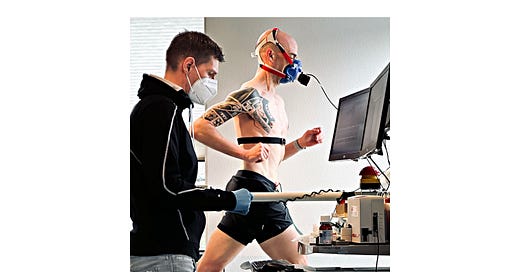




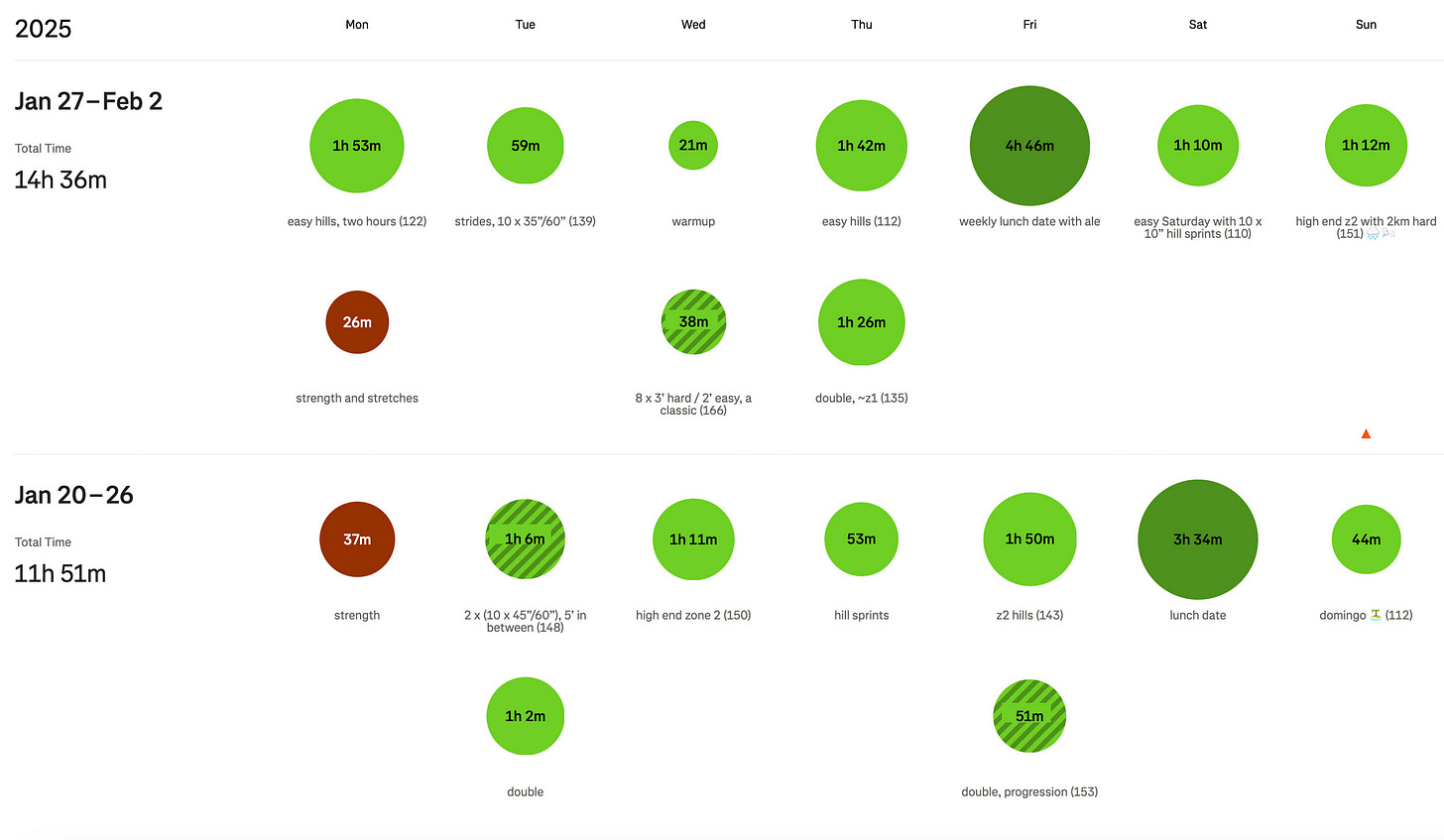
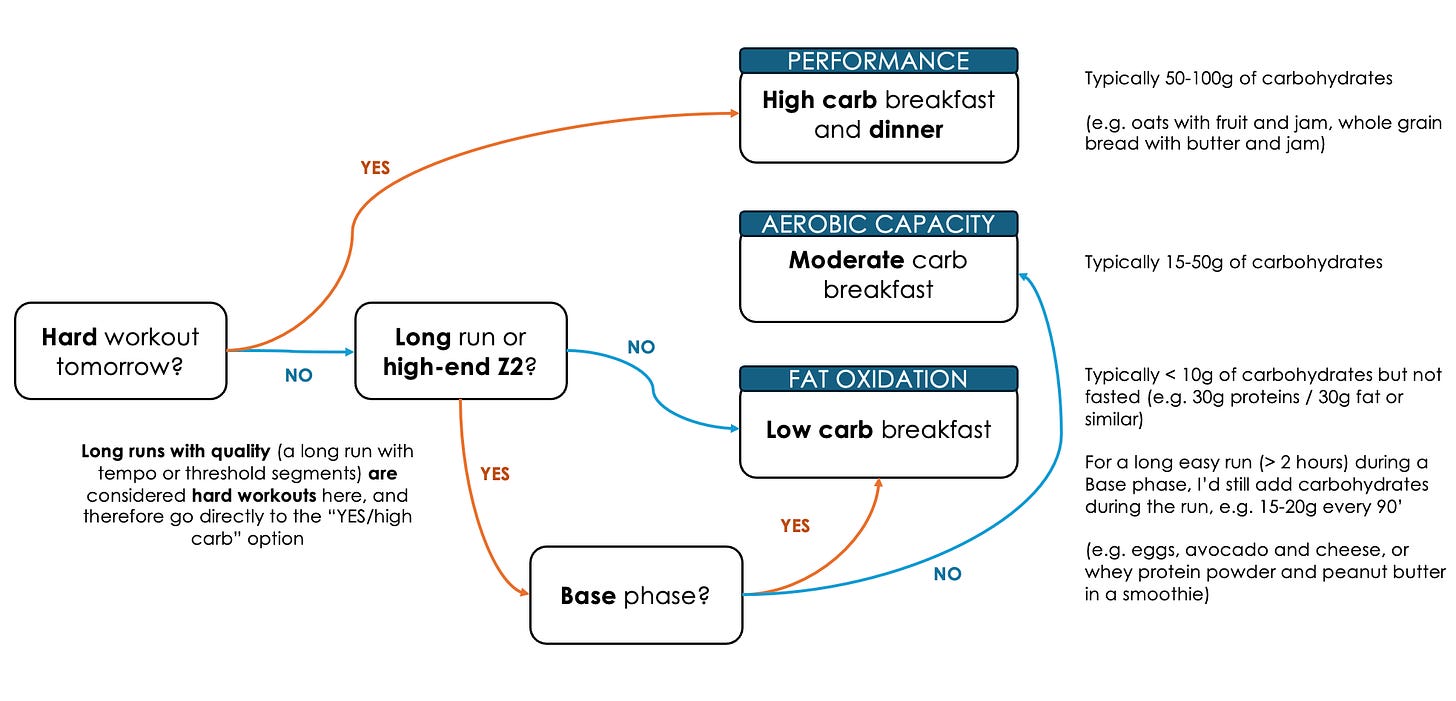
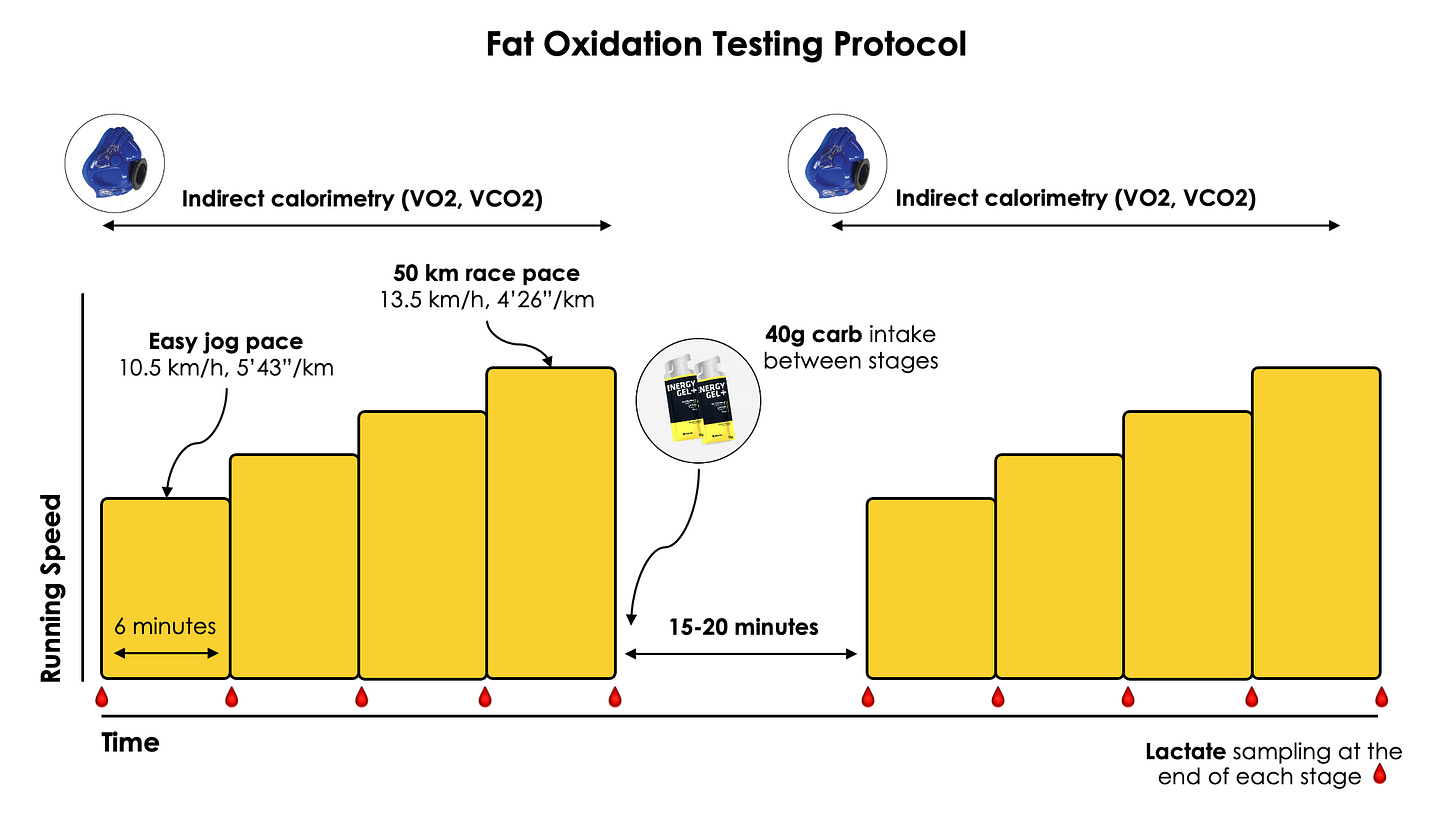

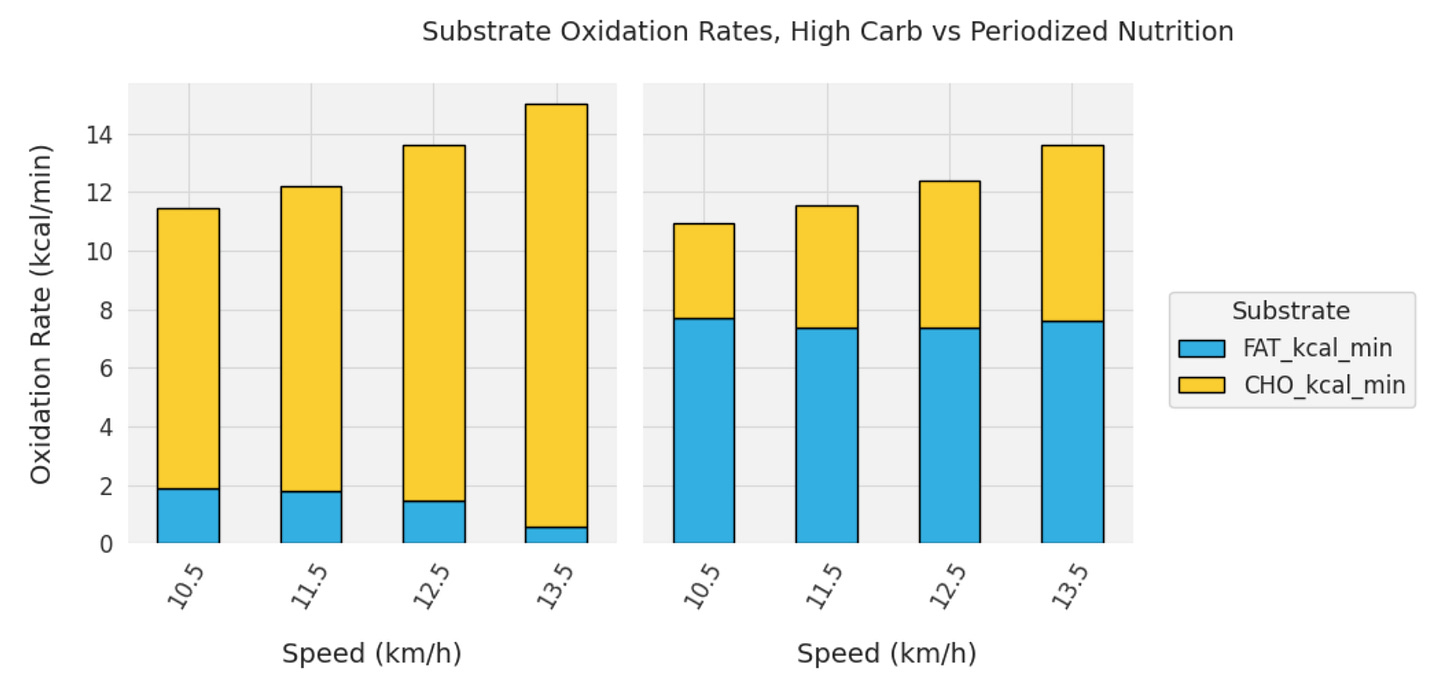

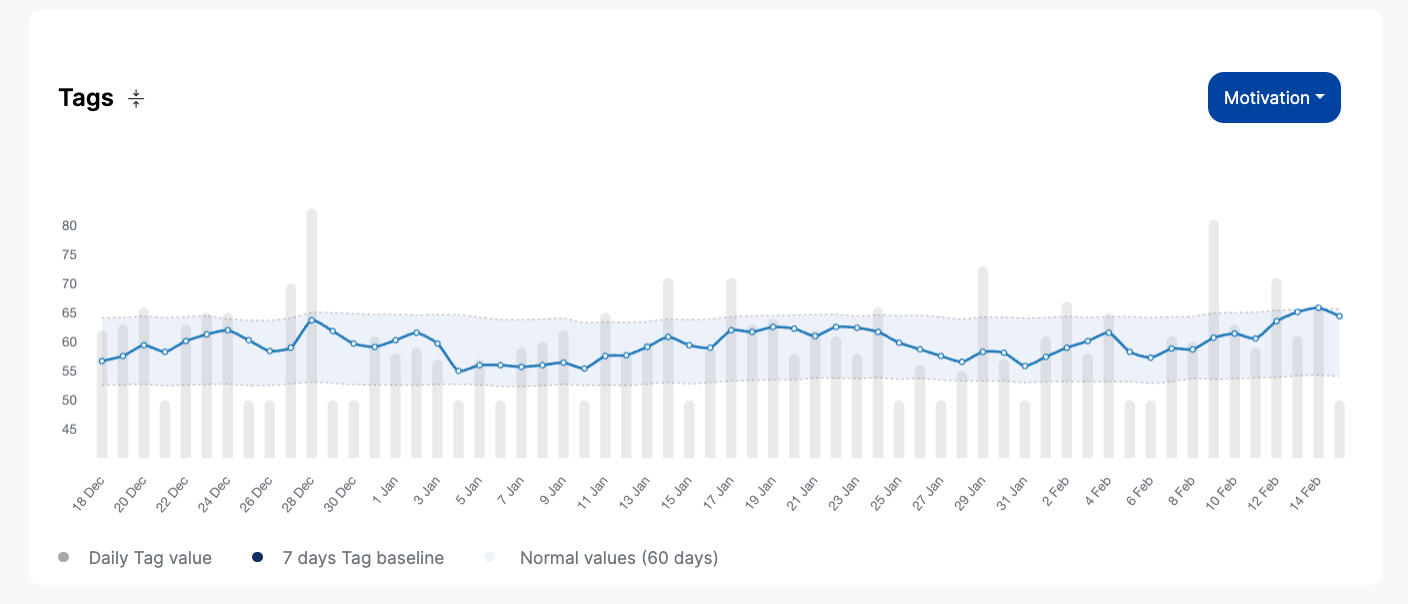
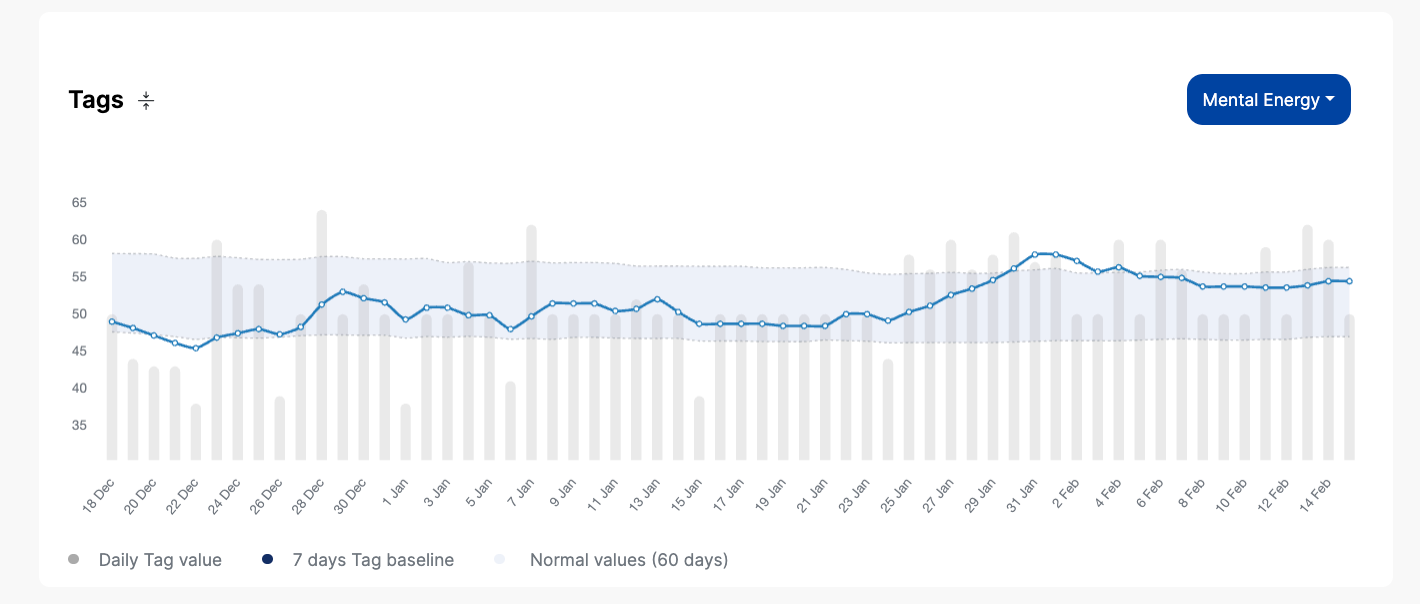


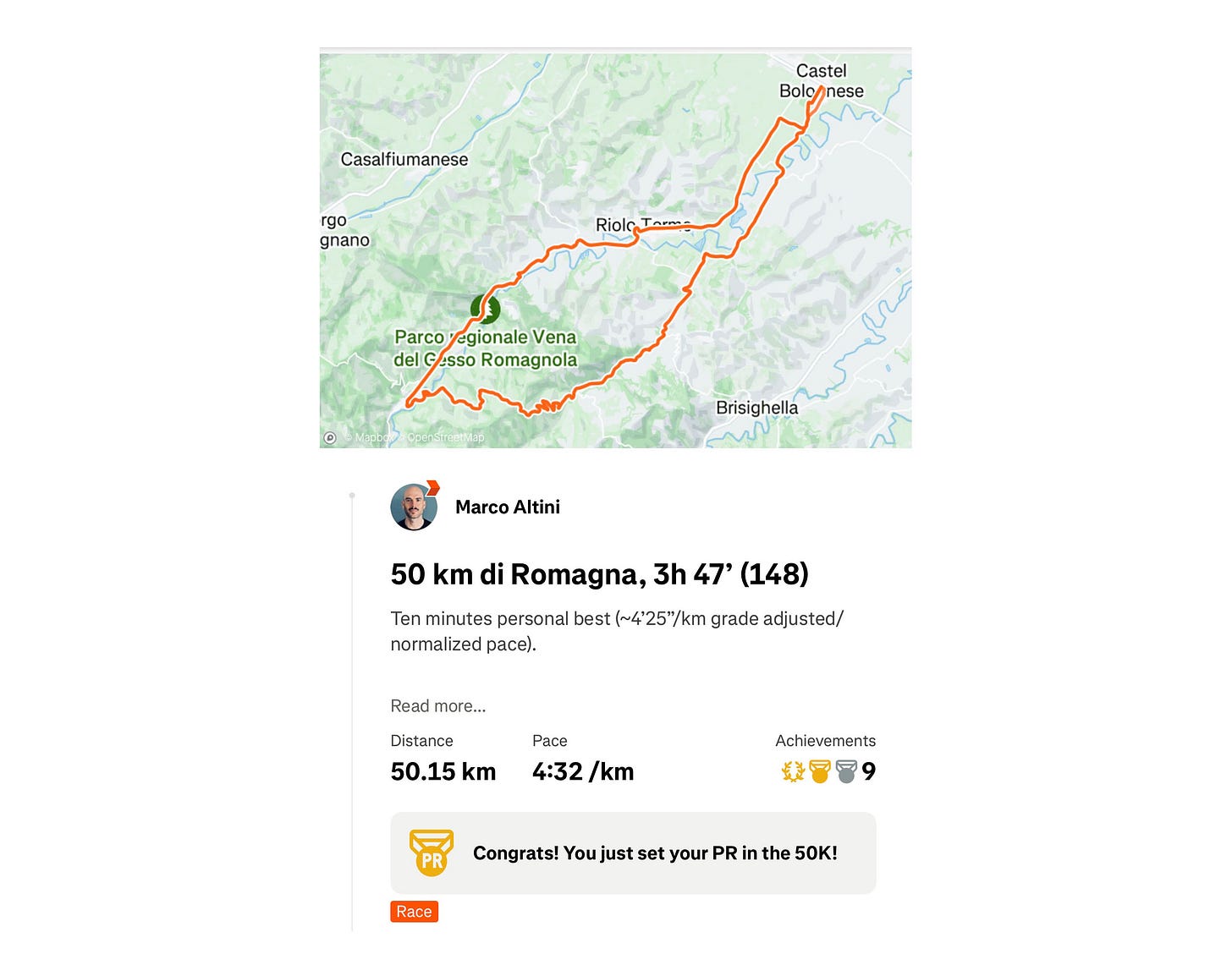
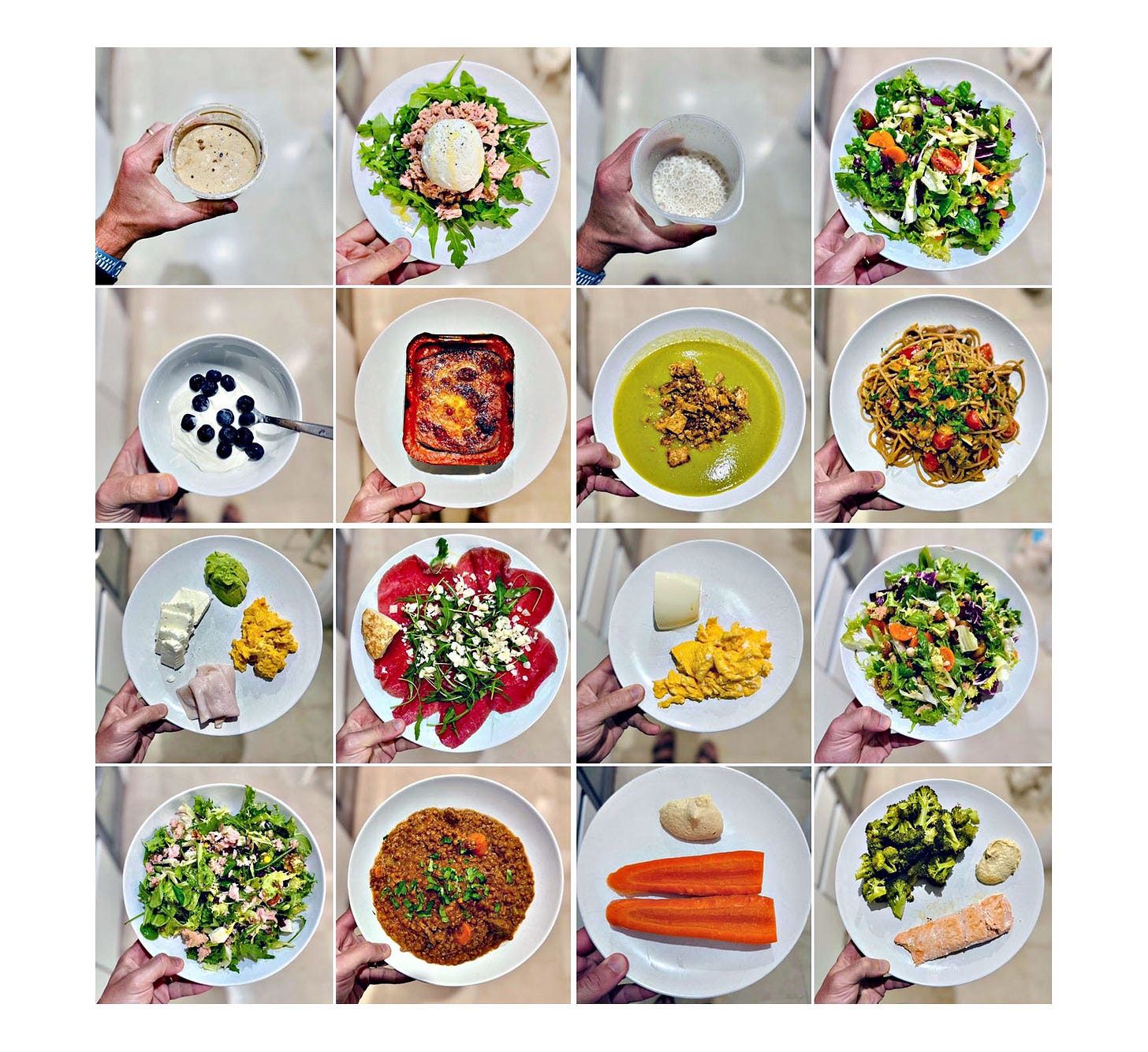




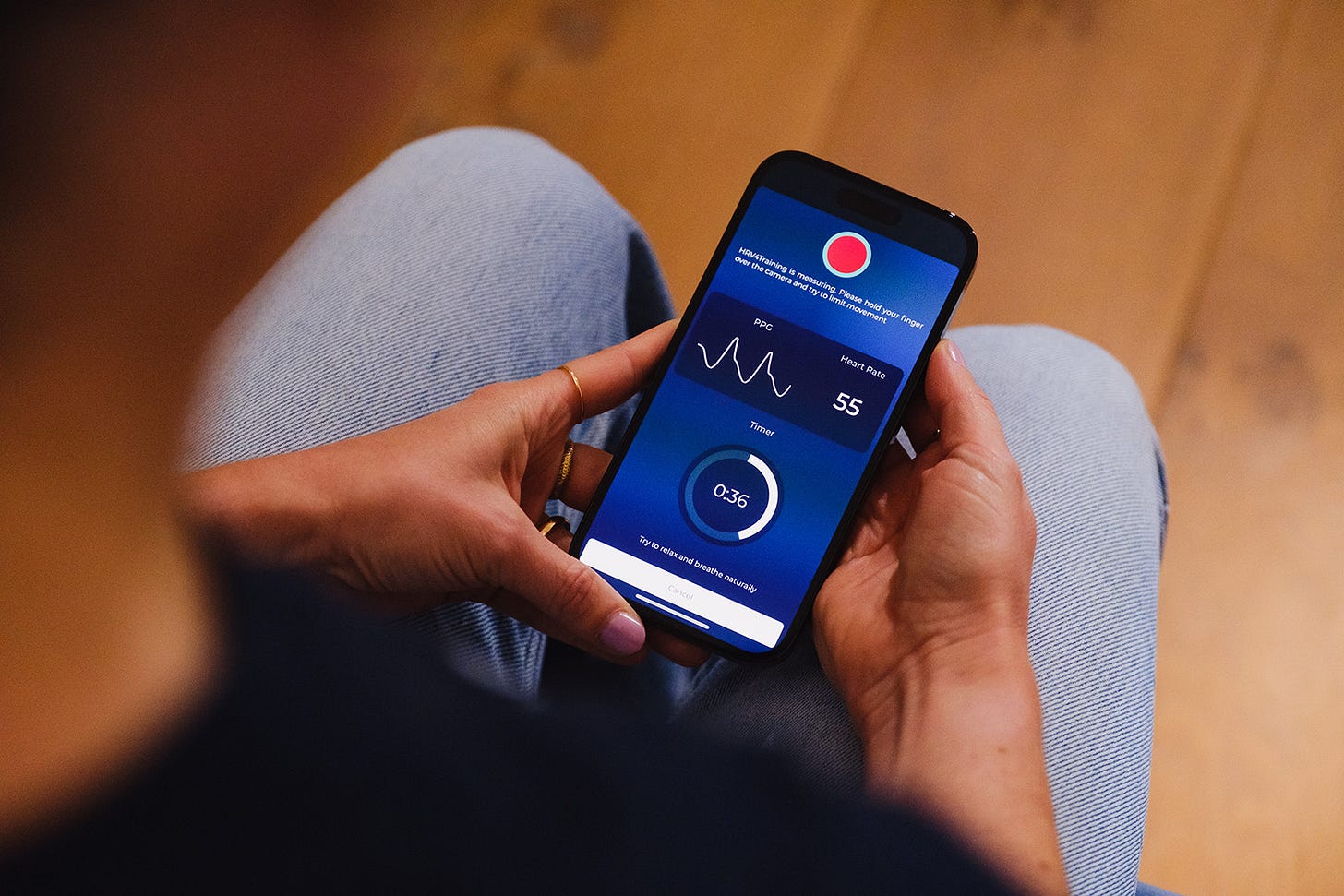
this is spectacular explanation of N=1 experiments with lots of insights
so excellent data match with personal needs and intuitions, paying attention to how quality of life during day, sleep, performance, recovery look like in these month, adjusting for different training and... yess I think a bit of effort and courage to test something extremely new
chapeau @marco :))))))))
Ciao Marco,
Perdonatemi per questo lungo commento, ma leggere e rileggere il vostro blog e ascoltare i podcast stimola davvero la mia piccola mente appassionata di sport!
- Again, congratulations for your dedication, navigating such diet changes in the pursuit of racing goals is purely amazing
- Was there a gradual cut of carbs before December/January or was it more direct process ?
- It would be nice to have the written percentages on the histograms of your macro distribution
- I would also be interested in knowing your energy expenditure at the pace you take for examples in your oxidation rates
- I see that you’re often very low in carbs (<50g) despite training everyday, that’s quite a challenge to go lower 50g of carbs. I guess you must cut off anything starchy and get your carbs from vegetables to stay this low. I will have to start a new love with broccoli if I go this way…
- I see AC back in 2008 having good results with an athlete with still quite a lot of carbs, of course everyone is different, but his strikes me : « I put this athlete on a diet of 400g of CHO/200g of (lean) Protein and 100g of (good) Fat. This represents 3300kcal/day and 48%/24%/28% macronutrient breakdown. Irrespective of whether the diet is eucaloric or not, I have found these percentages to be ideal in the base phase of training. » I have computed my macros this week and I was 39%/21%/39% and I feel like I have plenty of room in terms of fat oxidation (last time I measured I was 0.6 g/min at FatMax…)
- Also DP seems to have some divergent opinion from BS when writing « Remember that exercise duration is the most potent stimulant for fat oxidation; this is above specific macro-nutrient manipulation. » So my remark is that your ability (dedication and lifestyle) to do super long training might also be a key to drive fat oxidation. Do you have data to support that your workout duration distribution has not changed and that weight loss and macronutrients distribution (+strides) were the drivers of your improvement this year ?
- On your hard workouts days, I feel like you still stay under 250g of carbs, am I right ?
- After the 1st of February I am amazed that you are hovering over 2000 kcal only on lighter days. I know BMR and EE during exercise are hard to « measure » but still, it strucks me…
- Do you plan rest days ? I guess you keep the carbs super low when you do no train ?
- I feel like it’s difficult to get my calories needs if I don’t eat often. Do you think it’s even more ok to eat often when you eat fat and protein as snacks vs carbs ?
- I find super interesting that you keep the fat oxidation abilities when having some carbs before exercising, that’s big news to me.
- About LCHF and "LMHR" people, we have already discussed this... the Keto-CTA study has been quite something on socials (the speed of rising of the plaque is stunning !) and I am highly convinced that the keto crowd is falling into cognitive biais when they don't take actions in front of a big LDL-C or CAC score. Frankly, even just thinking of going on Periodized Nutrition and knowing my ability to produce LDL-C, I would put myself on a statin giving that I would rise drastically saturated fats in my diet. I know you have proven with adding a lot of fibers that we can manage LDL with periodized nutrition but my previous experiments show me that I don't reduce much my LDL with psyllium...
- We all crave for more recipes and menu ;) let’s add a cooking section to the blog ;)
- Eventually graze mille for sharing all your journey with us with such dedication. You add Signal in a noisy world of information.